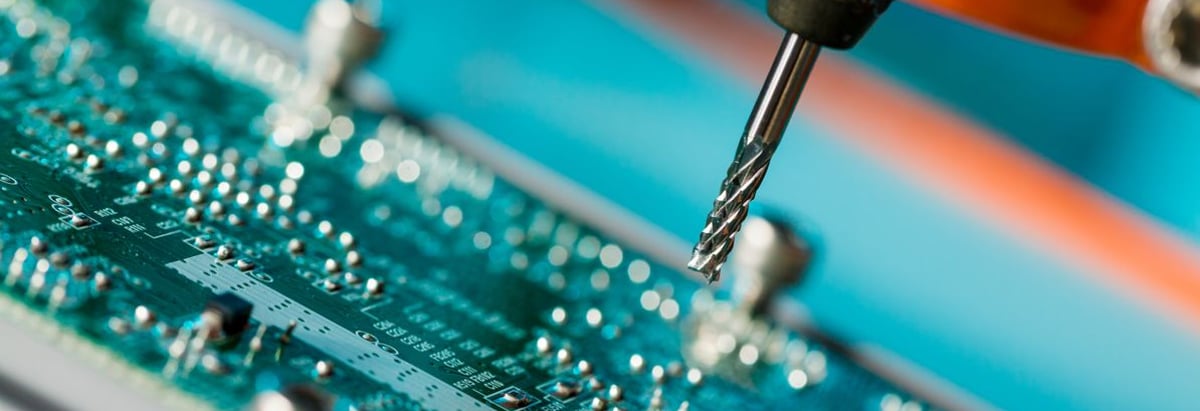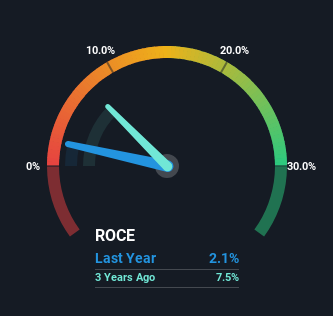- South Korea
- /
- Semiconductors
- /
- KOSDAQ:A217500
Capital Allocation Trends At Russell (KOSDAQ:217500) Aren't Ideal

What trends should we look for it we want to identify stocks that can multiply in value over the long term? Typically, we'll want to notice a trend of growing return on capital employed (ROCE) and alongside that, an expanding base of capital employed. Ultimately, this demonstrates that it's a business that is reinvesting profits at increasing rates of return. Having said that, from a first glance at Russell (KOSDAQ:217500) we aren't jumping out of our chairs at how returns are trending, but let's have a deeper look.
Understanding Return On Capital Employed (ROCE)
For those that aren't sure what ROCE is, it measures the amount of pre-tax profits a company can generate from the capital employed in its business. Analysts use this formula to calculate it for Russell:
Return on Capital Employed = Earnings Before Interest and Tax (EBIT) ÷ (Total Assets - Current Liabilities)
0.021 = ₩1.2b ÷ (₩82b - ₩23b) (Based on the trailing twelve months to June 2024).
Thus, Russell has an ROCE of 2.1%. Ultimately, that's a low return and it under-performs the Semiconductor industry average of 5.4%.
See our latest analysis for Russell

Historical performance is a great place to start when researching a stock so above you can see the gauge for Russell's ROCE against it's prior returns. If you want to delve into the historical earnings , check out these free graphs detailing revenue and cash flow performance of Russell.
What Can We Tell From Russell's ROCE Trend?
In terms of Russell's historical ROCE movements, the trend isn't fantastic. Over the last four years, returns on capital have decreased to 2.1% from 11% four years ago. Given the business is employing more capital while revenue has slipped, this is a bit concerning. If this were to continue, you might be looking at a company that is trying to reinvest for growth but is actually losing market share since sales haven't increased.
Our Take On Russell's ROCE
In summary, we're somewhat concerned by Russell's diminishing returns on increasing amounts of capital. Long term shareholders who've owned the stock over the last five years have experienced a 23% depreciation in their investment, so it appears the market might not like these trends either. That being the case, unless the underlying trends revert to a more positive trajectory, we'd consider looking elsewhere.
One final note, you should learn about the 3 warning signs we've spotted with Russell (including 1 which is a bit unpleasant) .
If you want to search for solid companies with great earnings, check out this free list of companies with good balance sheets and impressive returns on equity.
New: AI Stock Screener & Alerts
Our new AI Stock Screener scans the market every day to uncover opportunities.
• Dividend Powerhouses (3%+ Yield)
• Undervalued Small Caps with Insider Buying
• High growth Tech and AI Companies
Or build your own from over 50 metrics.
Have feedback on this article? Concerned about the content? Get in touch with us directly. Alternatively, email editorial-team (at) simplywallst.com.
This article by Simply Wall St is general in nature. We provide commentary based on historical data and analyst forecasts only using an unbiased methodology and our articles are not intended to be financial advice. It does not constitute a recommendation to buy or sell any stock, and does not take account of your objectives, or your financial situation. We aim to bring you long-term focused analysis driven by fundamental data. Note that our analysis may not factor in the latest price-sensitive company announcements or qualitative material. Simply Wall St has no position in any stocks mentioned.
About KOSDAQ:A217500
Russell
Manufactures and sells semiconductor equipment in South Korea, the United States, China, Japan, Malaysia, Singapore, Germany, and internationally.
Excellent balance sheet and good value.
Market Insights
Community Narratives



